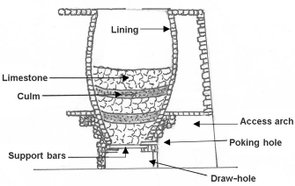Heritage Trail Board 5 – The Limekilns
The Caldon canal was completed in 1777 and served the northern part of the Cheadle coalfield and the limestone quarries at Caldon Lowe. Tramways  were constructed to carry the limestone down from Caldon Lowe to the canal wharf at Froghall. Some was used in the Froghall limekilns but the rest went out by narrow boat to other canal side limekilns, like those at Consall and Cheddleton. With the opening of the Uttoxeter canal in 1811, this included Oakamoor.
were constructed to carry the limestone down from Caldon Lowe to the canal wharf at Froghall. Some was used in the Froghall limekilns but the rest went out by narrow boat to other canal side limekilns, like those at Consall and Cheddleton. With the opening of the Uttoxeter canal in 1811, this included Oakamoor.
Lime was an important material in the making of both mortar and iron. It was also used for agricultural purposes. Adding lime to the soil reduced acidity and imcreased crop yields. In some areas lime was made from chalk but in North Staffordshire, it was made from limestone. In both cases it was burnt in a limekiln to produce quicklime, crushed to a powder and, eventually, slaked with water.
The kilns at Oakamoor were continuous draw kilns. The kiln was a brick lined “pot” with a stone face and was built into a bank. This allowed easy access to the top for loading in alternate layers of coal and limestone. As the coal burned, the limestone turned to quicklime which was then removed through a draw hole at the bottom of the kiln. The last burning of lime at the Oakamoor kiln was in 1921.
